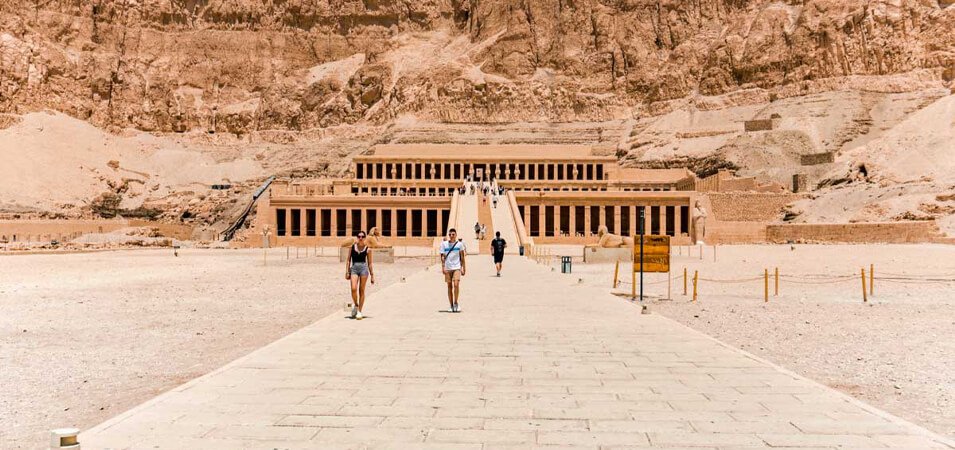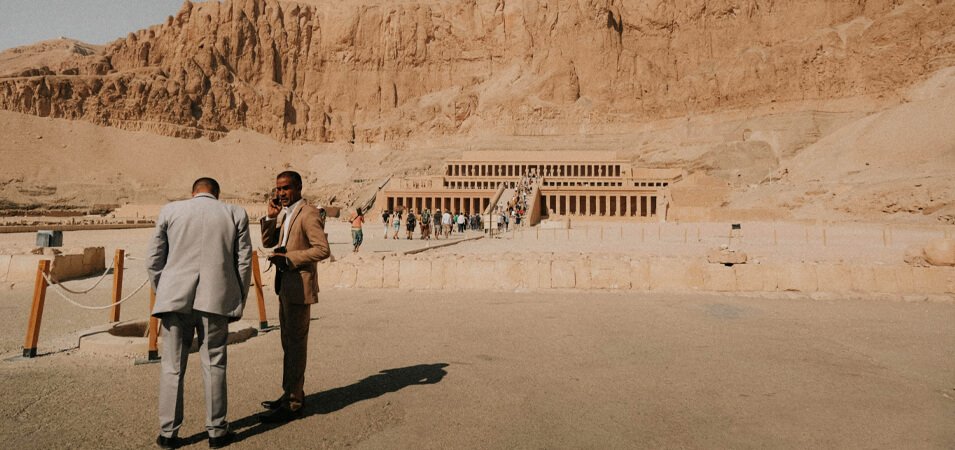Imagine a monument rising majestically from the desert cliffs, its terraces adorned with hieroglyphs whispering tales of a forgotten era. This is Hatshepsut Temple, an architectural marvel carved into the cliffs of Deir el-Bahari, on the west bank of the Nile near Luxor, Egypt. Nicknamed the “Djeser Djeseru” or “Holy of Holies,” Hatshepsut Temple stands as a testament to the reign of Hatshepsut, one of the most fascinating female pharaohs in ancient Egypt.
More than just a stunning monument, Hatshepsut Temple is a captivating blend of history, architecture, and artistic brilliance. History buffs will be enthralled by the story of Hatshepsut, a woman who defied tradition to become a pharaoh. Architecture enthusiasts will marvel at the temple’s unique three-tiered design, a masterpiece of engineering ingenuity. And anyone with an appreciation for beauty will be awestruck by the intricate carvings and hieroglyphs that adorn the temple walls, offering a glimpse into the beliefs and rituals of ancient Egypt.

The Rise of a Female Pharaoh: Hatshepsut’s Journey to Power
Breaking with tradition, Hatshepsut defied societal norms in a male-dominated society. Through clever political maneuvering and religious pronouncements, she declared herself pharaoh. Hieroglyphs depict her adorned with the pharaonic beard and kilt, a powerful symbol of her claim to the throne.
Challenges undoubtedly arose. Some officials might have questioned her legitimacy. But Hatshepsut was a shrewd ruler. She commissioned obelisks at Karnak celebrating her divine birth from the god Amun, bolstering her claim. Additionally, she focused on economic prosperity, leading successful trade expeditions to Punt, a land rich in resources.
Hatshepsut’s reign wasn’t solely defined by the temple.
- Economic Boom: Hatshepsut oversaw a period of economic prosperity. She revitalized trade routes and led successful expeditions to Punt, securing valuable resources like gold, ebony, and incense.
- Ambitious Building Projects: Her reign witnessed a flourishing of construction projects. She restored monuments, built temples, and left her mark across Egypt. A notable example is the Mortuary Temple of Ineni, her loyal steward, showcasing her appreciation for her advisors.
- Patron of the Arts: Hatshepsut was a patron of the arts. Her reign saw a flourishing of artistic expression, evident in the intricate carvings and hieroglyphs adorning the temple walls at Deir el-Bahari.
Hatshepsut’s story is one of remarkable ambition, political savvy, and a commitment to leaving a lasting legacy. Her reign stands as a testament to her exceptional abilities as a pharaoh, defying expectations in a male-dominated society.
Architectural Marvel of Hatshepsut Temple
Hatshepsut Temple isn’t just a historical monument; it’s a masterpiece of architectural design. Carved into the cliffs of Deir el-Bahari, the temple boasts a unique three-tiered structure, each level imbued with symbolic meaning.
While the exact inspiration for the design remains debated, some scholars see influences from the earlier Speos Artemidos, a rock-cut temple dedicated to the goddess Artemis. However, Hatshepsut Temple takes this concept to a grander scale. The three terraces rise majestically from the desert floor, each symbolizing the ascent to the heavens.
Ascending the Terraces:
- Lower Terrace: The first terrace welcomes visitors with a wide, open courtyard bathed in sunlight. Colonnades with lotus and papyrus motifs flank the sides, offering shade and a sense of grandeur. Reliefs adorning the walls depict scenes from Hatshepsut’s trade expedition to Punt, showcasing her prosperity and connection to foreign lands.
- Middle Terrace: A gentle ramp, adorned with statues of lions, leads to the middle terrace. Here, colonnades with more intricate designs and hieroglyphs depicting Hatshepsut’s divine birth story line the walls. This terrace also features a hypostyle hall, a vast space with rows of towering columns, creating an atmosphere of awe and reverence.
- Upper Terrace: The final ascent leads to the Upper Terrace, the holiest space in the temple. Here, sanctuaries dedicated to Hatshepsut and the god Amun reside. The walls are adorned with intricate hieroglyphs detailing religious rituals and offerings. This terrace offered a secluded space for the pharaoh to connect with the divine.
A Story Etched in Stone:
One of the most captivating aspects of Hatshepsut Temple is its use of hieroglyphs. These carved symbols aren’t mere decoration; they tell a story. The walls throughout the temple are like an open book, depicting scenes from Hatshepsut’s life, her accomplishments, and her connection to the gods. These hieroglyphs offer invaluable insight into ancient Egyptian beliefs, rituals, and the life of this remarkable pharaoh. Hatshepsut Temple is a testament to the architectural ingenuity of the ancient Egyptians. Each element, from the tiered layout to the intricate carvings, serves a purpose, creating a space that is both visually stunning and deeply symbolic.
More Than Stone and Sand: Significance of Hatshepsut Temple
Hatshepsut Temple wasn’t just a monument to Hatshepsut’s reign; it served multiple purposes. Here’s a breakdown of its significance:

- Mortuary Temple: Primarily, the temple served as a resting place for Hatshepsut’s spirit after death. The sanctuaries on the Upper Terrace were dedicated to rituals honoring the pharaoh and facilitating her transition to the divine realm.
- Place of Worship: The temple also functioned as a place of worship for the god Amun, the king of the Egyptian gods. By dedicating a portion of the temple to Amun, Hatshepsut cleverly linked herself to the divine, solidifying her claim to the throne.
- Window into the Past: Beyond its historical and religious significance, Hatshepsut Temple offers a priceless window into ancient Egyptian life:
- Architecture: The temple’s design reflects the Egyptians’ sophisticated understanding of engineering and their connection to the natural world.
- Beliefs: The hieroglyphs adorning the walls provide a treasure trove of information about their religious practices, rituals, and concepts of the afterlife.
- Enduring Legacy: The temple we see today is a testament to ongoing restoration efforts. Over time, wind, sand, and even deliberate damage took their toll. Through meticulous restoration work, archaeologists and conservators have painstakingly brought this magnificent structure back to life, ensuring future generations can appreciate its beauty and historical significance.
Hatshepsut Temple stands as a powerful symbol of a remarkable pharaoh, a testament to ancient Egyptian ingenuity, and a window into a lost civilization. It’s a place that inspires awe, ignites curiosity, and reminds us of the enduring power of human ambition and artistic expression.
Conclusion
Hatshepsut Temple isn’t just a monument; it’s a captivating journey through time. We’ve explored the story of Hatshepsut, a pharaoh who defied tradition and left an indelible mark on history. We’ve marveled at the architectural brilliance of the temple, a testament to the ingenuity of ancient Egypt. We’ve delved into the temple’s significance, a place of worship, a royal mortuary, and a window into a lost civilization.
Standing tall against the desert sands, Hatshepsut Temple continues to inspire awe and ignite curiosity. It’s a reminder of the power of ambition, the beauty of artistic expression, and the enduring legacy of a remarkable pharaoh.
FAQs
1. Why is the temple of Hatshepsut so important?
The temple of Hatshepsut is important for several reasons:
- Historical Significance: It was built by one of the most powerful female pharaohs in ancient Egypt, Hatshepsut, and stands as a testament to her reign.
- Architectural Marvel: The temple’s unique three-tiered design and intricate carvings offer valuable insights into ancient Egyptian architecture and engineering.
- Religious Significance: It served as a mortuary temple for Hatshepsut and a place of worship for the god Amun, revealing details about Egyptian beliefs and rituals.
- Window into the Past: The hieroglyphs adorning the walls provide a wealth of information about ancient Egyptian life.
2. Was Hatshepsut buried in the temple?
No, Hatshepsut wasn’t likely buried in the temple itself. The temple functioned as a mortuary temple, a place where offerings were made to ensure her spirit’s well-being in the afterlife. Her actual tomb was most likely carved into the cliffs behind the temple.
3. What god did Hatshepsut worship?
Hatshepsut likely worshiped a variety of gods, as was common in ancient Egypt. However, the temple dedicates a significant space to the god Amun, the king of the Egyptian gods. By incorporating Amun into the temple’s design, Hatshepsut may have been solidifying her claim to the throne by linking herself to the divine.
4. Why did Hatshepsut dress as a male?
Pharaohs in ancient Egypt were traditionally seen as embodiments of the god Horus, a male deity. Hatshepsut, as a female pharaoh, sometimes wore the pharaonic beard and kilt in public depictions to solidify her legitimacy as ruler and connection to the divine.
5. Who was the most powerful queen in Egypt?
Hatshepsut is a strong contender for the title of most powerful queen in Egypt. Her reign was marked by prosperity, successful trade expeditions, and ambitious building projects.
6. Did Hatshepsut marry her brother?
There’s no concrete evidence that Hatshepsut married her brother, Thutmose III. She may have served as regent for him during his youth, but most likely did not marry him.
Read other Related Articles:
